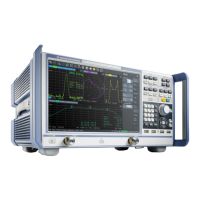Concepts and Features
R&S
®
ZNB/ZNBT
188User Manual 1173.9163.02 ─ 55
If the trace is displayed in "Delay" format, changing the offset parameters simply shifts
the whole trace in vertical direction.
The sign of the phase shift is determined as follows:
●
A positive offset parameter causes a positive phase shift of the measured parame-
ter and therefore reduces the calculated group delay.
●
A negative offset parameter causes a negative phase shift of the measured param-
eter and therefore increases the calculated group delay.
5.6.1.7 Offset Parameters for Balanced Ports
The offset parameters can be used for balanced port configurations:
●
Offset parameters must be assigned to both physical ports of a logical port.
●
"Auto Length" corrects the length offset of both physical ports of a logical port by
the same amount.
5.6.2 Embedding and Deembedding
The R&S ZNB/ZNBT allows you to define virtual networks to be added to/removed
from the measurement circuit for a DUT with single ended or balanced ports. This con-
cept is referred to as embedding/deembedding.
The embedding/deembedding function has the following characteristics:
●
Embedding and deembedding can be combined with balanced port conversion: the
(de-)embedding function is available for single ended and balanced ports.
●
A combination of four-port and two-port networks (not necessarily both) can be
applied to balanced ports; two-port networks can be applied to single ended ports.
●
A combination of four-port and two-port networks can be applied to any pair of sin-
gle-ended ports. Moreover it is possible to combine several port pairs in an arbi-
trary order (port pair de-/embedding).
●
Single-ended and/or balanced port (de-)embedding can be combined with ground
loop (de-)embedding. A ground loop models the effect of a non-ideal ground con-
nection of the DUT.
●
Transformation networks can be defined by a set of S-parameters stored in a
Touchstone file or by an equivalent circuit with lumped elements.
●
The same networks are available for embedding and deembedding.
5.6.2.1 Embedding a DUT
To be integrated in application circuits, high-impedance components like Surface
Acoustic Wave (SAW) filters are often combined with a matching network. To obtain
the characteristics of a component with an added matching network, both must be inte-
grated in the measurement circuit of the network analyzer.
The figure below shows a DUT with a single-ended and a balanced port that is com-
bined with a real matching circuit and a physical unbalance-balance transformer
(balun) to be evaluated in a 2-port measurement.
Offset Parameters and De-/Embedding

